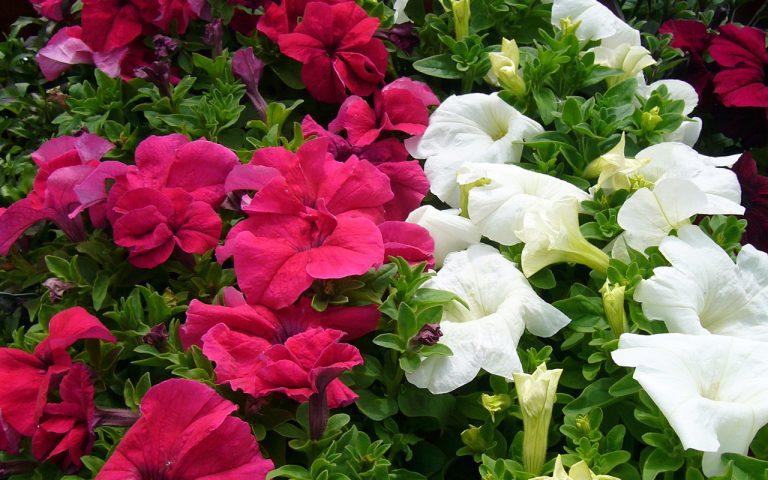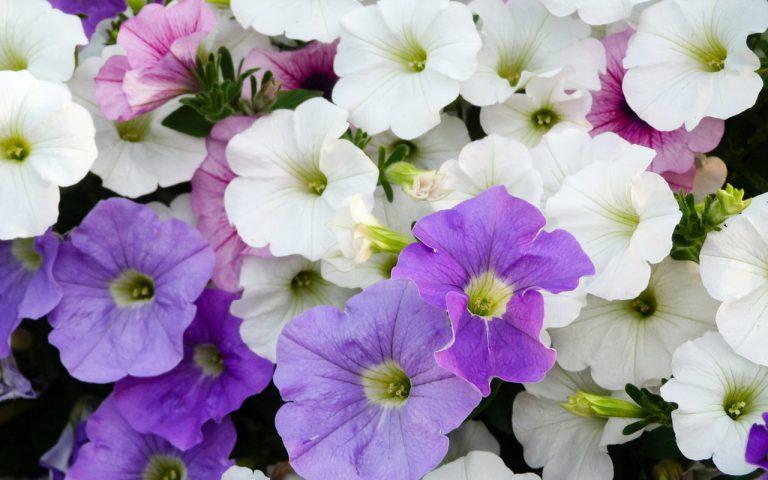Menu

It’s that time of year – you can’t pass a high street without seeing trolleys of summer bedding plants on display! And why not? They are a relatively cheap way to fill your garden, balcony or window box with cheerful summer colour, that can last all season with a little care and attention.
If you haven’t grown your own from seed this year, here is our guide to the whats, whys and hows of summer bedding to keep you blooming.
Summer bedding is a general term applied to fast-growing, flowering plants that can be used to provide a colourful season display. They are usually fairly low-growing and usually annuals (they grow and flower in one year) but there are exceptions to both: cosmos can grow up to a metre in height, for example, and pelargonium and geraniums can last for years with a little care and protection.
Amongst our top five most popular summer bedding plants are:
Lobelias: dainty cascades of blues, purples and white are great for hanging baskets and borders.
Geraniums: echoes of a traditional alpine cottage in bright reds and shocking pinks (that can last longer than just the summer with some shelter).
Petunias: trumpet flowers in all shades of blues and purples for added drama.
Marigolds: sunshine-coloured flowers that are great for bees and other pollinators.
Gazanias: suited to hot, dry spots, they will keep flowering until the first frosts.
We have all of these – and more – in stock at our Titchfield Garden Centre in the spring and early summer.
Sometimes other plants are included under the ‘summer bedding’ umbrella. Sweet pea, for example, are annuals which can add height, drama and scent to your summer schemes. Cineraria are often sold as bedding plants more for their dramatic silver foliage than their flowers. Pansies and violas – if given a little love – can even start as spring bedding and keep flowering on through!
Most summer bedding plants are very susceptible to frost. This is either because they are annual plants, so are still very young and tender when they go on sale, or because they are varieties that don’t tolerate frost – or both! This means it’s important not to plant them too soon. If you are planting up pots or hanging baskets with summer bedding, it is really worth keeping them in a sheltered spot until the plants have established and any risk of frost has passed. We’d usually say by the end of May but who knows with English weather! Keep an eye on the weather forecast for any unseasonal, overnight cold spells.
Anywhere you like! We’ve all seen fantastic shows of summer bedding livening up parks, pubs and neighbours’ gardens, a testament to the fact that you really can plant it anywhere. The only caveat has to be that you will need to get to it, for watering and dead-heading, if you want to keep it looking great all summer.
Summer bedding looks particularly good bursting out of hanging baskets, spilling over borders or packing out pots. Because you are – probably – only expecting one season from these plants, the usual rules about giving each plant its own space don’t have to apply. Yes, you will need to at least water them, but you can let the exuberance of their flowers and colours carry you away if you want!
A good general purpose, peat-free compost is probably the best thing, but your own garden soil will be perfectly fine too. You might want to ‘pimp’ your soil or compost with some extra nutrients to keep your plants fed all summer long. Most commercial compost mixes contain enough nutrient to keep plants fed for about eight weeks so consider adding a slow-release plant food or some organic matter (well-rotted horse manure or homemade compost, for example) to give it an extra boost from the start. We sell a selection of feeds that may be suitable, including pellets and drip-feeds that could save you having to feed later in the season.
Whatever plants you have chosen, there are really only two things you need to remember: keep them well watered and keep removing the spent flowers.
Watering: when you first plant, water them in well, regardless of what the weather is doing. A good soak will help ensure their roots make good contact with the soil around them. After that, a weekly watering for anything in a bed or border should be enough. Pots and hanging baskets may require twice weekly, or even every day if it’s really dry, but keep an eye on moisture in the soil (stick your finger in) to make your own judgement. Remember that a really good soak is much better than little sprinkles; the water has better chance of getting right down to the roots than evaporating away. And timing matters; if you can, water early in the morning or later in the evening, away from the heat of the day, again so less evaporates and you don’t risk scorching the leaves. If you are going for a big show, you might want to feed fortnightly with a general purpose or high potassium liquid feed, to promote flowering.
Deadheading: when a flower has finished doing its thing, it will usually turn into seeds or fruit ready for next year’s plants. However, because we’re going for an annual display, we want the plant to concentrate its energy on more flowers instead. Every few days, just nip off any flowers that have gone over to ensure it does this. It’s not a big job and often a pleasant excuse to wander round your garden in the cool of an evening! Little and often will get better results but if you only have time at the weekends, it will still be a big help.
Summer bedding is really quite easy to look after so you really can’t go wrong. But, in our experience, the most common mistakes are three that we have already touched on in this article:
1) Planting out too early. Planting while there is still a risk of frost, or serious downpours, can kill or seriously damage your plants before they have had a chance to establish.
2) Not dead-heading. Removing spent flowers ensures the plant will grow new ones. Leaving them on will mean the plant goes to seed much sooner and stops looking its best quicker.
3) Letting them dry out. Because they are putting such energy into their displays of flowers, your summer bedding needs to be kept moist. If you’re going away for more than a week, it’s worth setting up a watering system or enlisting a reliable neighbour to help ensure they still look stunning when you return!

Yes and no – it will depend on the plant variety!
If you’ve chosen plants that are annuals – that grow, flower, seed and die in the same year – then they clearly won’t last. Typically these include plants such as pansies, petunias, sweet pea, cosmos and some varieties of antirrhinum (snap dragons). However, you could leave the last few flowers on at the end of the season to let them form seeds. Store the seeds somewhere dark and dry over the winter and sow them when things warm up in the spring. For free plants, it’s worth a try! (Find our guide to sowing seeds here).
However, some plants that are sold as summer bedding are perennials and, with a little care, you can keep them for next year. This includes pelargoniums, lobelia, geraniums and cineraria, for example. The most important thing is to protect them from the cold. When you’re ready to move them at the end of the summer, bring them inside to a bright but sheltered spot (inside the house may be too warm for them but an unheated conservatory or heated greenhouse is ideal). Let them dry out a bit, to give them a bit of rest, and don’t worry if some of the leaves fall off. A few weeks before you want to put them out again next summer, give them a bit of trim for shape and repot them into new, rich soil or compost. Start watering them again and bring them outside on fine days to reacclimatise to outside temperatures.
Further reading this month:
Summer bedding is used to great effect in our Coronation planter, here
What (else) to plant in May
Jobs in your garden this May
Jobs in your garden for June
Tips for looking after your garden while you’re away
Hambrooks garden design, landscaping & garden maintenance throughout Hampshire for over 50 years.

